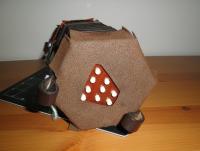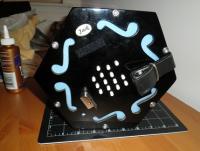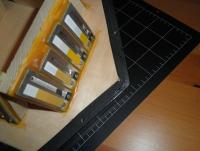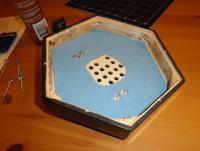-
Posts
129 -
Joined
-
Last visited
Everything posted by Johanna
-
How bad is the soreness/numbishness? If it's so bad that it's painful for you to play (or use the finger for anything else), that may be a sign of a bad playing habit. Are you trying to use your index finger to help support the weight of the concertina? (If you are, you might need to adjust your handstraps or something.) Or, if you feel you're pushing the button harder than necessary, you're probably right, and you should try to overcome that. For example, when I first started playing, I had to really work to overcome my intuitive feeling (left over from my piano playing days, I guess) that pushing a button harder would make the note sound louder. Obviously, it doesn't work like that on a concertina, but my fingers didn't know it yet. On the other hand, if your finger just feels a little tingly, and you've been practicing for hours and hours, it's probably nothing to worry about. It's normal for your fingers to rebel against being used in ways that they're not accustomed to. Maybe slow down your practice schedule just a little for the time being - and pity the poor beginning guitar players, who have it much worse.
-
In my personal opinion, sight-reading is overrated. When you've truly mastered a tune, it will be in your aural memory and your muscle memory. At that point, you won't need the dots in front of you, and keeping them there will only serve to distract you from what's really important, which is the sounds that you're producing. Printed music is great for showing you the bare bones of how a tune is supposed to go in the first place, especially if you don't have a recording of it (or even if you do). As long as you can read music slowly, you can pick through the tune and get a basic feel for it, then strive to rid yourself of the printed music as quickly as possible. Listening skills are far more important than music-reading skills, because there are aspects of music that the printed page can convey only imperfectly, if at all: phrasing, attacks, accents, dynamics, slight changes in tempo, etc. Whether I'm listening to someone else's playing (and trying to imitate it) or my own, I find that it's much easier to focus on those nuances when I don't think of the tune in terms of the dots on the page, but instead am fully focused on the sounds. Sight-reading skills are optional: There's no reason you can't be a good or even great musician without being able to read music at all. Listening skills are mandatory.
-
My band had its first full-length performance recently, and all the songs from our first set are up on youtube. Unfortunately, all the songs in which I do anything interesting on the concertina are in the second set - in the first set you get to see a lot of me singing while holding a concertina in my lap. (But at least that means I'm not playing any wrong notes!) Here's one where I play:
-
Argh...I've been on the lookout for a baritone just like this, but unfortunately I just put down a thousand quid for a Lachenal new model tenor, and another concertina purchase so soon just isn't in the cards. I hope it goes to a good home.
-

newbie & want to learn concertina
Johanna replied to halimium's topic in General Concertina Discussion
Something to be careful of with Scholers - the one I have (that I bought for $35 for the purpose of tinkering with it until it breaks) is tuned somewhere in between D/A and Eb/Bb, and I think somebody here said once that they're all like that? I don't know if the guy on Melodeon.net tunes them as a part of his tweaking, but if not (or if you get one from somewhere else), that could be frustrating if your aim is to play with other instruments. -
The Jack (as well as the Jackie and the various 30-button Stagis) is a bit more limiting in this regard. The standard English keyboard, of course, has both G# and Ab, and both D# and Eb, so you can reach for whichever is more convenient in the key you're playing in. But the Jack has only one of each in each octave, so you have to break from the left-right-left-right pattern more often. Still, you can play in keys with up to two sharps or flats with no problem. Getting back to Don's question: Yes, looking at printed music as a series of intervals rather than absolute notes can be a useful way to look at it. In addition to being able to transpose to different keys, it has the advantage that you can read music in "weird" clefs (of which there are many), not just the standard treble and/or bass. But I think it's even more useful to look at printed music as a crutch that you want to rid yourself of (for a particular tune) as soon as you possibly can. It's good for learning what the tune is in the first place, but you can't really claim to have mastered a tune until you have it in your ears and your brain and your fingers, so that you no longer need your eyes on the page. Once you know a tune by heart (not just by memory) you can work out how to play it in whatever key or octave you like. This is something that I never really "got" until I started playing concertina (despite more years than I care to admit of piano and violin lessons in my younger days). It came as something of a revelation.
-
Another thing: I would not assume that the low notes on a Morse (Geordie or Albion) baritone will be as cranky as the equivalent notes on a Jack. The responsiveness and tone of a reed depends on how the reed is made, not just on what the note is. Melodies that are "too low to be pleasant" in the low octave on the Jack may sound just fine on the Morse. I've never played a Morse, though. Before you decide which one to get, you should talk to someone who has. If there's a way you can have a go on one yourself, that's even better. You might find that you don't need the bigger range of the Geordie after all (and might do just fine with an Albion, for example). There is plenty of music you can make in two and a half octaves. Don't assume that you absolutely must have a larger range unless the music that you're trying to play tells you that you do.
-
Being able to play the same melody in different keys or in different octaves is a useful skill to have. Whether it's useful for you to be developing it right now, only you can say. It sounds like you've hit on the right strategy: keep playing the exercises in both octaves if it's not too confusing, but if it is, then stop. Another option would be to transpose up a fifth - take an exercise that's printed in C, but play it in G. Then you can keep basically the same fingering pattern - all you have to do is add in the F-sharps where appropriate.
-

newbie & want to learn concertina
Johanna replied to halimium's topic in General Concertina Discussion
Please point out where I made this argument. You must be reading a different post than the one I wrote. -

newbie & want to learn concertina
Johanna replied to halimium's topic in General Concertina Discussion
A thought, possibly the wrong one: If money is really that tight, are you sure the concertina is the right instrument for you? Rochelles, Jackies, Elises, and Stagi/Bastaris are fine as they go for getting started, but if you decide as you progress that you want to get serious about the concertina, there's a good chance you'll want to upgrade. And as has been mentioned, good concertinas get very expensive very quickly. It's one thing to not want to spend too much on your first concertina before you know whether you like it or not. A lot of us started on inexpensive boxes and have no regrets. But if you can't see yourself ever wanting to spend much more than £200 on a concertina (and I realize that's not what you said), you might be better off picking a different instrument from the start. -

Joy of a Broken Finger
Johanna replied to Constant Screamer's topic in General Concertina Discussion
It was a broken arm that got me started on the concertina in the first place. When I got my cast taken off and got back full use of my hand, I still had to wear a splint on my wrist, so I couldn't play the guitar, so I went out and got a concertina. I like to pair "Off She Goes" (in D) with "The Oyster Girl" (in G). The transition between tunes works in both directions, so you can switch back and forth between them as often as you want. -
Just saw this - from the pictures posted, the concertina is missing half its buttons and at least 1/4 (I suspect all) of its reeds. Obviously I'm not going to bid on this, but I wonder how it would be covered under eBay's buyer protection. What if it was bought by some unsuspecting person who didn't know what the inside of a concertina was supposed to look like? Or what if the seller hadn't posted the picture of the reed pan? Does advertising something as a "concertina," even if not in working order, imply that all the important parts are at least present?
-
I recently got a copy of "Jump At The Sun: The John Kirkpatrick Tunebook" (from here). There's a lot of good stuff in there. I can learn tunes by ear, but it's so much easier to have dots in front of me too. Especially for the tune's that he's written (and recorded) to be played as canons, the dots are a big help to figure out what is going on.
-
The other two on the same track as The Three-Speed Plough - The Hafren Hornpipe and a Half, and Unchristmas - are both a lot of fun as well. I've been working on those, and figured I should try The Three-Speed Plough too to round out the set.
-
I know that tune well from Hannah James and Sam Sweeney's album, where they do the A section in parallel thirds (second part a third below the melody) and it sounds lovely. I've always played it by hopping the same finger between the notes a 5th apart...thanks for the reminder that I should take the time to relearn it properly.
-
Thanks for all the replies. I've tried Jim's suggestion (without the c-sharps), and I think that with practice I can make that work. It's great that you all are here to ask about things like this.
-
I'm trying to learn "The Three-Speed Plough," by John Kirkpatrick, on EC. The last measure of the A section (attached) leaves my fingers tied up in knots. No matter what I do, I have my third finger on the second C, and no fingers left to play the F sharp that follows. Is there any way to play this? It's a nice tune, so I'd hate to give up on it. plough problem.pdf
-
You're telling me. Here are some better photos that should tell you all you need to know about what I did to make it.
-
You don't really need to be a technical genius - you mostly just need to know how to use a screwdriver. (That said, my Jack has always been my secondary or tertiary concertina - if it were my main instrument, I doubt I would have poked at the innards quite so boldly.) Here are some pictures. The first one shows the outside (with the baffle installed). Take out the six screws from around the edge, and the end will come off. The second picture shows the underside of the end. Note the tiny screw that's barely visible right at the corner. There is a second one 180 degrees opposite. Take these out, and the plywood piece will come loose from the outer black celluloid end. The third picture shows the baffle inside the end - it's just held in place with a few drops of glue. You can see that I didn't do a very precise job of cutting it. It still seems to work fine. I got the ultrasuede (for both concertinas) from a company called Knoll Textiles. They offer free samples that are the perfect size for this job. I don't know if they'll send them outside the US, though.
-
If a concertina is too loud for you, you can always add baffles to soften the tone. Baffles traditionally go inside the concertina (which involves taking it apart), but you can also put them outside. Here is a picture of my Stagi 18-button miniature with external baffles. I just cut them out of ultrasuede (any sound-absorbing fabric will do, I'd think) and attached them with velcro. They really do make a difference in volume - without them, I couldn't practice in my living room for more than a few minutes without giving myself a headache. I also have a Jack, to which I've added internal baffles (only because the ultrasuede pieces I had were not big enough to make external ones). If you like, I can take pictures of those and explain how I made them. baffled stagi.tiff
-
Sounds like a great opportunity for both of you. What songs are you preparing?
-
I can't speak for the rest of the band...but I think we might be willing to pay quite a lot.
-
Thanks, John. We actually have two banjo players on that song. Would you like one? There's a mandolin in the mix, too. But (1) it's hard to hear, because it's playing almost the same thing as I am, and (2) the mandolin player was the one who posted the video, and she's too modest to mention herself in the video description.
-
This is my band, Shenandoah Run:






